Wakodahatchee Field Guide
Palm Beach’s Wakodahatchee Wetlands is a 50 acre artificial wetland that was created by the Palm Beach Water Utilities department on unused utility land to provide a wetland habitat for wildlife and migrating birds as well as a natural way to return purified water to the aquifers. It’s name is derived from the the Seminole language and means “created water”.
Wakodahatchee is one of two artificial wetlands in Delray Beach, and offers a much smaller and more intimate setting that it’s sister site, Green Cay. Wakodahatchee features a 3/4 mile elevated boardwalk trail so visitors can observe and photograph the wildlife within the wetland areas. Due to it’s size, and the boardwalk’s location in the heart of the wetlands, Wakodahathcee provides a very intimate environment for observing and photographing wildlife.
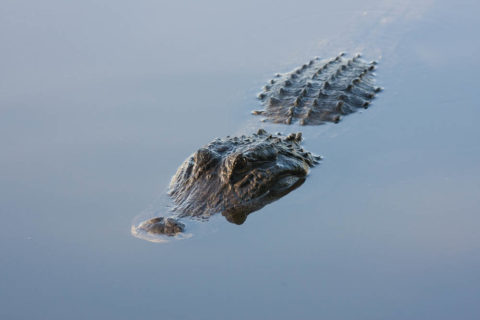
The wetlands attract over 140 species of birds, snakes, turtles, alligators, and other wildlife. Wakodahatchee is open from sunrise to sunset, providing great access during “golden hour” for photographers. The refuge features a verity of different wetland environments, from open water areas used by fishing birds to emergent marsh areas and shallows for wading birds, to small islands and lightly forested areas. There are even small grassy areas where it’s common to see rabbits, raccoons and other small mammals.
Wildlife
When visiting the wetlands, the resident wildlife will vary depending on time of day and year. Wildlife typically seen consists of waterfowl, wading birds, fishing and diving birds, birds of prey, small mammals like rabbits and raccoons, and reptiles such as turtles, snakes and the alligators. Moorhens, egrets, herons and various birds of prey as well as many smaller birds like Palm Warblers are seen year round. Activity picks up during the winter as migratory birds start arriving. In addition during the winter months, Red-winged Blackbirds, Purple Gallinule and Double-crested Cormorant become more visible.
Peak season is in the late winter and spring, which the majority of birds are nesting or rearing young. Things settle down more in during the hot summer with the exception of Tri-colored herons, who are quite active rearing their young at that time. The fall is probably the quietest season, offering only limited opportunities with resident birds, Anhinga, Heron, and Egrets dominate the limited population during this time.
The resident reptile population consists of American Alligators, and several species of turtles. The alligator population is quite strong for such a small area, including breeding. Alligators can be found in all sizes from fully mature adults to freshly hatched juveniles depending on the time of the year.
Wakodahachee Map
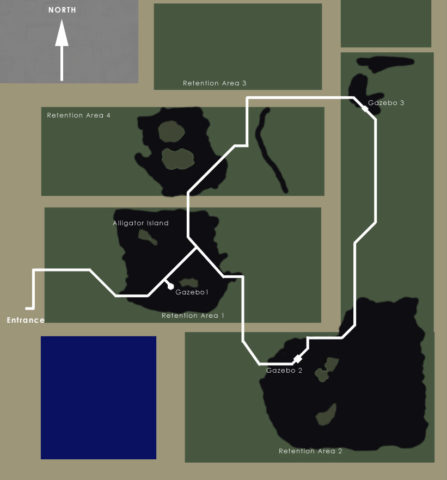
Photography Guide
Introduction and Considerations
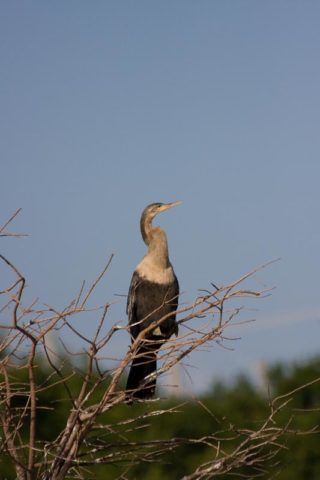
The best time to photograph Wakodahatchee is in the mid to late winter and spring, into the early summer. As usually ideal times are during “golden hour” just after sunrise and before sunset, as such this guide focuses more on locations that have better light during the winter–when the sun is further south in the sky–and sites that produce imagery during the best light. As always one should be aware of their surroundings so as not to miss any great opportunity, and with as much wildlife as Wakodahatchee packs in during the peak season there will be plenty of those.
The major axis of the accessible areas run east-west and the horizons are thickly wooded in places, but their utility as a background is highly variable. In some areas they provide a very clean background while in others they are punctuated by buildings and utility lines. Wakodahatchee can present a challenge for lens selection as subjects can be very close to the boardwalk to quite far away. For those traveling light, a zoom lens with some reach (300mm at least) is probably the most flexible solution though many of the more experienced photographers will be using a long prime (500mm f/4) and a shorter zoom (70-200 f/2.8 or f/4).
Probably the two biggest advantages Wakodahatchee has over it’s sister site Green Cay, is it’s intimate nature and the design of the railing on the boardwalk. Unlike Green Cay you’re frequently right in the middle of the action. The boardwalk is close enough to nesting and perching sites that you don’t need a ridiculously long lens to casually photograph them.
The other is the design of the railing. As many experienced wildlife photographers know, the key to better images in generally is cleaning up the background so it doesn’t distract from the subject. To do this generally you need to make the distance between the background and subject larger than the distance between the subject and the camera, or use a very long lens that can isolate the subject more readily.
For those who don’t have a ridiculously long fast lens the best advice in increasing the subject-background distance is to get lower. And this is where the design of the guard rails comes into play. At Green Cay the spacing is small enough that it’s all but impossible to get anything larger than the barrel of a 70-300mm lens without it’s lens hood. Wakodahatchee has a slightly wider spacing making it relatively easy to poke a larger lens though (or retain the lens hood). As such it’s much more practical to shoot through the bottom railing while laying on the boardwalk deck here than at Green Cay.
Gear
For a novice photographer who wants to cary a single, the minimum that I’d consider carrying is a 70-300mm zoom on a crop body. A 55-200 or 55-250 would do if that’s all you got, but your going to find yourself wishing you had more reach.
For someone more advanced looking maintain a single lens setup, I’d consider a zoom with a larger range, Canon’s EF 100-400 f/4.5-5.6L IS USM or Nikon’s AF Nikkor 80-400mm f/4.5-5.6D ED, would be the next step up. Someone seeing the ultimate in flexibility on a budget should consider fielding a Sigma 50-500 f/4-6.3 DG or Sigma APO 150-500mm f/5-6.3 DG OS HSM, for the ultimate in reach.
More advanced shooters should bring their 500mm f/4 prime and their 70-200. Those who are Nikon shooters can easily get away with their AF-S VR Nikkor 200-400mm f/4G IF-ED, especially if they are using a 1.5x crop body, as most things don’t get too far away from the walkway. A teleconverter is also a good idea, just in case.
Often many of the larger subjects are close enough that an unaided 500mm lens is more than sufficient to get frame filling images. Also consider, that all the paths are boardwalks, there often is no way to zoom with your feet and in many cases moving to a closer spot along the boardwalk can cause you to loose a favorable background.
After shooting here for some time, I have mixed feelings towards whether a full frame or crop format camera is more beneficial. There certainly isn’t a clear case against full frame like there is at somewhere like Green Cay. The intimate nature of the area, makes it much easier to shoot with a full frame camera with out having to haul out a 600mm lens or longer or stack tele-converters or something crazy like that. Though the crop format always gives you the advantage of a “free” teleconverter and the ability to use smaller lighter lenses, which shouldn’t be underestimated.
When I started, shooting here, I often elected to not carry a tripod. This was partly because the boardwalks can get quite cramped especially during the peak of the season (winter and spring) with many photographers lined up to shoot a given subject and many non-photographers out walking or otherwise enjoying the weather and wildlife. And partly because image stabilization and a monopod can make up for some of the instability that not having a tripod brings.
That being said, I almost always carry a tripod now because it’s much easier to sit on a subject for a long time when you don’t have to hold the camera up and because as good as image stabilization technologies are, they don’t work as well as having your camera on a tripod. If you’re just starting out with this, or looking to fly light, a lens with a good stabilization system and a monopod is quite workable so long as you don’t mind loosing shots during first light and later into sunset.
Like all outdoor and wildlife photography, shutter speeds become a ballancing act. Though because of the openness of the environment maintaining shutter speeds in the 1/1000th of a second range, even at f/5.6 or 8 is quite possible at ISO 400 and often at ISO 200 as well.
One thing you wont need here is a wide-angle lens. There really is very little in the form of a sweeping vista. The property is smack in the middle of Delray Beach and is bordered by a water treatment plant and a housing development. Also there are few places where the 70mm end of a 70-200mm or 70-300mm lens, even on a crop camera, can take in the whole scene.
Where the Shots Are
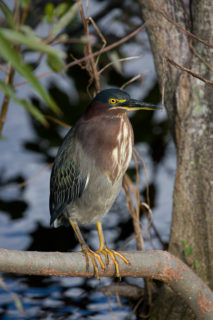
The question of where to photograph from and when, is a little more difficult. It’s a good idea to take into consideration the time of year and the sun’s location in the sky. In the winter the sun is more southerly in the sky offering better lighting on views on the northern side of the boardwalks. In the summer, when the sun is directly overhead, the views to the south work just as well. Of course in the morning the best light is predominately in views looking to the west and east respectively.
The wetland area can be principally divided into four main areas, they are separated from each other by earthen berms topped by trees. Three of them are accessed by the boardwalk running thought them, the forth is more limited with access being via a paved path running along it’s south edge. In this guide, I’ll describe the each of the areas and what’s commonly found there starting with the walk leading in, then proceeding around the loop boardwalk in a clockwise manner.
The Entrance Path to the First Gazebo
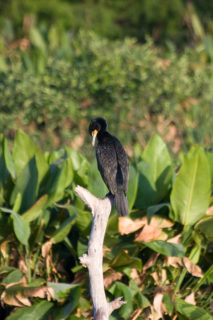
The first area you traverse when coming in is the entrance walkway. The walkway is predominately east-west in orientation but does curve. You start high over the wetlands at the top of a berm on the western edge. The walkway quickly slopes down to the level it maintains throughout the rest of the wetland. The first third of the entrance path is through shallow marsh area. Smaller herons and egrets (Cattle and Snowy Egrets, as well as Little-blue and Tri-Colored Herons) as wells as ducks, Moorehens and Gallinule are also seen in the water foraging in here.
Where the boardwalk makes it’s first southeasterly turn, there’s a decent opportunity to the north-east where the vegetation opens up and you have clean water for a background. In the afternoon this location can produce favorable quite decent images, and seems to be a favorite of photographers.
Also the area along the southern edge of the boardwalk starting just before it curves, is tall Fire Flag, on which you can often find Purple Gallinule and Red-winged Blackbirds perched or foraging.
Continuing along the trail towards the first gazebo, the water deepens and as a result opens up. There is a small island to the north of the walkway which usually has an Alligator sunning on it, and is also a common nesting location for Great-blue Herons. Closer to the boardwalk is a tree stump, that’s commonly used by Anhinga and Cormorants as a place to dry as well as a place for turtles to climb out of the water and sun themselves.
The horizons along this area are decent. The norther one is quite heavily wooded. The northern part of the western horizon and the western part of the southern horizon aren’t nearly as nice.
The First Gazebo and the Path to the Loop
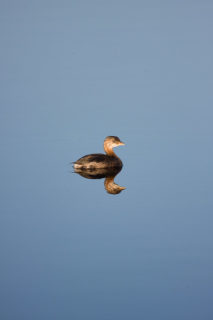
The first gazebo overlooks a decently sized island to it’s east. There is frequently a Great-blue Heron nest on the southwestern corner of this island, and it’s easily photographed from the gazebo in the afternoon. Though you have to be careful as the loop boardwalk is visible in the background if you don’t control your camera angle and field of view.
The area north of the boardwalk views the open water and Alligator Island describe in the last section. When they are here, this is a good location to shoot Least Terns fishing, as they are frequently flying around in very rapid circles looking for small fish in the water below. The boardwalk also offers a good vantage of the tree on the east end of south island. This tree is almost always covered in Anhingas or Cormorants drying their feathers or resting.
The northern horizon is again quite nice with dense foliage. The western horizon is acceptable, so long as you can avoid the power lines that poke above the tree line. The southern horizon isn’t too bad either, as the island by the gazebo blocks most of lower part of it and the treeline above it is nicely developed.
The Start of the Loop to the Northern Tree Line
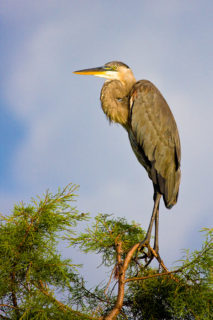
The entrance path terminates at a “T” intersection with the loop path. To the west of the loop path is the same Alligator Island previously described, it’s still quite distant from this location, but this is where you can get the closest to it. To the east, of the loop path is some more open water and then shallow emergent marsh type land, it’s still close enough that you can photograph wading birds at the edge of it and the open water with a 300mm to 400mm lens, but they do tend to be small in the frame.
You can occasionally find diving birds, like the Pied-billed Grebe or Cormorants swimming in the open water, if the wind is calm in the morning they make a pretty good subject along this stretch of boardwalk. This is also the only really accessible area of open water, with a good clean background.
The boardwalk in this section ends on a short section of paved path across the top of the berm separating areas. I don’t usually see an awful lot of anything on this crossing, but I have seen marsh rabbits off in the distance from here.
The backgrounds though out this part of the trail are quite decent and far enough away that even with a slow f/5.6 lens they are moderately blurred.
The Northern Pond
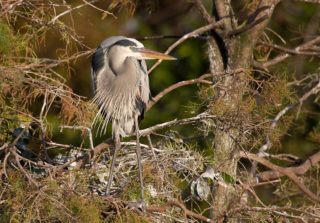
Continuing around the loop trail to the north is the second of 3 areas, where the boardwalk meanders though it. This area offers decent opportunities to photograph herons and and company in the trees on the two islands to the northwest of the path.
The eastern half of this section of boardwalk is situated in shallower emergent marsh land. There are decent opportunities usually to the north of the walk to photograph moorhens balanced on gnarled roots. The area also sees a host of smaller wading birds, like Little Blue Herons, hunting close to the walkway. As well as a few trees that seem to be favored by Anhingas to use as a drying perch.
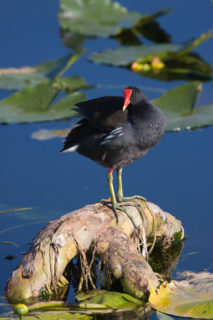
The backgrounds in this section can be less than ideal but by carefully controlling where you set up you can insure you have distant trees in the gaps and not buildings. The western edge is again punctuated by utility poles and buildings. The northern edge isn’t all that solid, with sizable gaps in places where you can see structures of the adjacent water treatment plant. The southern edge is solidly wooded though, and in the winter is in shade almost all day yielding a darker green background.
The North Path
For me at least, the least interesting section of trail is the northern most segment. It’s a paved walk way on the berm that separates the last area from the rest of the wetlands ot the north. It’s a nice section to walk along as it’s well shaded, and there are openings in the trees and brush that look back onto the northern area and the area to the north, but by not being in the middle of the marsh area, it’s quite difficult to get decent photographs of anything from here with out getting lucky (the alligator image on the first page was shot along this section).
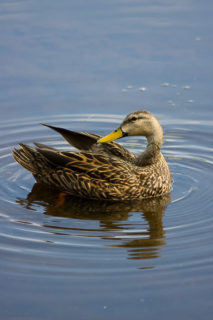
Backgrounds to the north are distant, but less than ideal. The Wakodahachee property adjoins a Palm Beach Water treatment plant, and some of the large structures are clearly visible on the northern and western horizons when shooting from here. Also the distance to them means that they almost always show up unless you have a very long focal length or are shooting downward towards something close. To the south, you’re looking back at the same nice treeline that forms the southern edge of the northern pond.
Eastern Path and the Third Gazebo
The north path ends and the boardwalk resumes at the edge of the largest single uninterrupted are of water. The terrain in the northern area is emergent marsh land with shallow water and lots of Fire Flag and duckweed. This starts at the north end by the gazebo and continues all the way south until the southern berm of the first area.
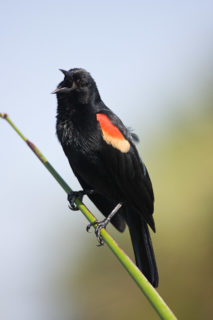
Starting at the north end, there are some decent opportunities around the gazebo. There is a small area of shallow moderately open water where herons and egrets can frequently be found feeding. It’s also north of the boardwalk so in the winter the light is relatively good regardless of the time of day.
Continuing south along the boardwalk opportunities diminish to some degree and decent backgrounds pretty much go away. There are opportunities here though, gators are often found paroling the “river” like area roughly half way between the north and south ends. Green heron and bitterns can typically be found perched on low branches and stalks, and when they are present Red-winged blackbirds and Boat-tailed grackles are common around here. Also it’s not uncommon to find a hawk in one of the trees as the berm to the west is open and grassy and marsh rabbits, squirrels and raccoons are frequently visible on it. At the southern end, the north-south section of the trail, there’s a birdhouse for smaller birds at the end of the berm to the west of the walkway.
Southern Path and Second Gazebo
About in line with the southern berm of the first area, the path turns back towards the west and the second gazebo and the water deepens and opens up. This is another good location to find Terns fishing durring the day, though it’s much more difficult to control the background as there is a housing development to the south and east, and the treeline isn’t very dense. In the deeper water to the south and east of the gazebo there are two islands, both are frequent nesting locations for herons and ergerts. Durring the late spring and summer these two islands are typically covered in juvenile Tri-colored herons. The islands are a better shoot in the afternoon as they are south and east of all the available shooting locations.
North of the boardwalk is the berm that seperates this area from the one you started in. There is frequently small birds perched in the trees around this area. At the western end by where the boardwalk crosses back over the berm, there frequently are Palm Warblers both in the marsh and in the trees. The area north of the boardwalk seems to be a bit better than the area south, both in terms of widllife and lighting.
The Southern Berm back to the Entrance Walkway
The final stretch of the loop boardwalk runs from where the boardwalk crosses the southern berm of the first area, back to the intersection with the entrance walk. On the berm there’s a good chance of spotting marsh rabbits, raccoons and squirrels.
After returning to boardwalk from the berm, the surrounding terrain is more shallow water emergent marsh with a lot of fire Flag. It’s not uncommon for Moorehens and Gallinule to be in and climbing on the Fire Flag, ducks and teals are often seen in the water to the east. Decent shots are available along this whole stretch of boardwalk.
Arguably the best subject in this section though is the great west looking view of the larger tree on the southern island in this area. The tree is frequently filled with Anhinga and makes of an interesting wider shot.
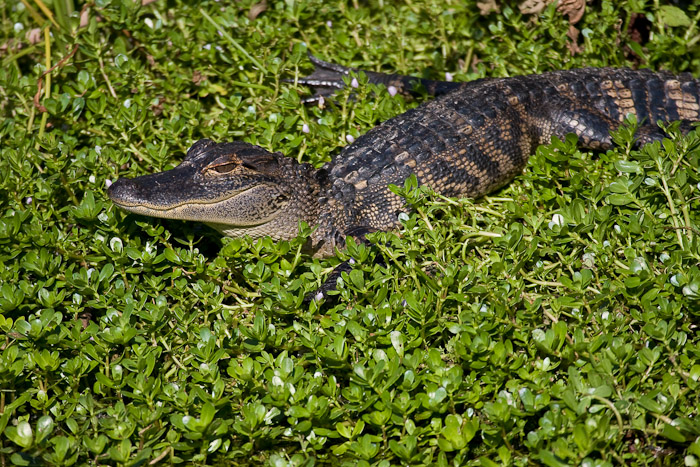
Comments
There are no comments on this article yet. Why don't you start the discussion?